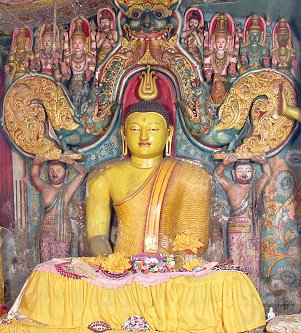
In 103 BC, King Vaţţagāmini Abhaya, popularly known as Valagambā, ascended the throne of Sri Lanka. After anointed king a young Brahamin named Tissa, in Rohana seat in Sri Lanka, led a rebel against the king. At the same time, Sri Lanka was invaded by seven South Indians (Damilas). Tissa the Brahamin and the seven Indian rebels sent the king a written massage concerning handing over of the parasol (symbol of kingly rank). The sagacious king sent a written message to Tissa Brahamin stating that the kingdom was his, therefore to conquer it. He fought a battle with invaders but he was defeated. Thereupon the South Indian invaders made war upon the king Valagambā and was forced to flee from Anurādhapura. The invasion caused a severe famine throughout the island. The famine became known as “Brahmana Tissa” famine. It devastated the whole country as people were unable to obtain any food and as a consequence many died. Large number of monks left Sri Lanka and sought shelter in India. Sacred shrines such as Thūpārāma and Mahā Thūpa (the colossal dāgaba in Anurādhapura built by King Dutugamunu) were left unattended and deserted.
Over the years it was overgrown with weeds and their precincts were grown over with vegetation. Some Arahant monks left Anurādhapura for the central hills in the island. Those monks who stayed back led a hard life and they preserved the teaching as enshrined in the Tipiţaka in oral form. While the South Indian armed forces ruled the country for twelve years, the king remained in hideouts in the dense jungle.
According to the Great Chronicles, Dīpavansa and Mahāvansa, the Fifth Buddhist Council convened at Aluvihāra because the Arahant monks saw the degradation of the Dhamma (Teaching). People at that time were not practicing the true Dhamma and so to preserve the true doctrine, (Geiger 1953: P 131) they held the Fifth Buddhist Council. Though the ancient sources like Dipavamsa and Mahavamsa are ambiguous on the notes concerning the ground, time, presidency, venue, participants, duration and its results regarding Aluvihāra Buddhist Council, Nikāya Sangrahaya, Asgiri Talpata record it at its best. Pujāwalie author is the first to give fresh and encouraging information much more than what the chronicles had recorded regarding the Aluvihāra council.
At the same time, a teacher from Pallavārāma monastery of Vajjiputtaka sect in India arrived here and became the teacher of Abhayagiri sect.
Theravāda, the Doctrines of
the ‘Elders’ commenced and was propagated in Sri Lanka with the advent of
Arahant Mahinda in the 3rd century BC. Theravādins preserved the Teaching with
complete respect and dedication. The rise of the powerful Mahayāna or Abhayagiri
sect, as how it had been called later in Sri Lanka, disturbed the Theravādins’
minds that it would strike root in the country.
The great advisor monk of the king Valgambā, Kupikkala Tissa Mahā Thero, was
excluded from Mahā Vihāra on a disciplinary action taken by the Mahā Theros in
Anurādhapura. Bahalamahalu Tissa Thero and Mahadeliyātissa Thero, two disciples
of Kupikkala Tissa Mahā Thero, disagreed with this action. In the first place,
Bahalamahalu Tissa thero took five hundred monks with him and set out to
Abhayagiri monastery and settled down there, marking out the first dissention in
the Sri Lankan monastic order.
The founding of the Abhayagiri sect in Sri Lanka was sponsored by Royalty. “The object of the convention was, however, not confined to the mere committal to writing of the master’s words but had in view also the provision of means of combating the heresy of the Abhayagiriya fraternity, which was then causing serious trouble at Anurādhapura” says H. W. Cawe.
King Valagambā reclaimed the throne in the 88 BC. For fourteen years he had remained a fugitive hiding in the central hills waiting for the opportune moment to reclaim his throne. According to the Great Chronicles, Dīpavamsa and Mahāvamsa, King Valagambā fled from Anurādhapura and took refuge in the rock caves in the central hills. He might have sighted the caves at Aluvihāra and earmarked it as a probable site for preserving the Tipiţaka at a later date. His choice would have been based on its remoteness and distance from the strife-torn Capital of Anurādhapura.
Manorathapurani or Anguttaranikayattakathā manifests that “To preserve the Tipitaka the Arahants convened southern mountainous area and lived at the bases of the mountains. There, they recited and memorized mounding sand as a pillow and resting their heads on it”
The Arahants who left the island converged again at Kallagāma, Mandalārāma in Sri Lanka after twelve years of famine. They tested their memory on the teaching of the Buddha. It was based on this discussion that they decided to commit the teaching to writing. It was unanimously agreed that Aluvihāra would be the venue for the writing of the Scriptures. The Nikāya Sangrahaya titled Fourteenth Century of Sinhalese History of Buddhism mentions about this pre-agreement on the Buddhist cannon that made before it was committed to writing at Aluvihāra. A controversy arose whether the doctrine would depend on Pratipatti ((Rules of conduct practiced by pansukulika monks) or Paryāpti (study the teaching of the Buddha). At the end of the debate the Paryāpti monks were victorious. It became an imperative at that time to write down the teaching of the Buddha to preserve and uplift it. This was what has been traditionally upheld at the three Buddhist Councils and brought down by word of mouth since Buddha’s demise (Parinibbāna). The forty-five year teachings of the Buddha is enshrined in the Tipiţaka. In the annals of Buddhism, three Buddhist councils were held at Rajagaha, Vesali and Pātaliputta in India respectively and the contents of the Teaching were continuouslyi Lankan monastic order. This Fourth Buddhist Council, which was held prior to the recording of Scriptures in books at Aluvihāra, was a landmark in the history of Buddhism.
It is clear that the famines, foreign invasions and internal dissensions widely disturbed the religious and social institutions in the island. During the time of King Vaţţagāmini Abhaya 88 B.C, it was felt that the continuance of the teaching through the form of recitals was no longer safe. The saņgha, the monastic order, assembled at Mahā Vihāra, the first monastery in Sri Lanka at Anurādhapura and took council together and with the assistance of the king, held convocation. The teaching was recited and arrangements were made to engage scribes to commit the Dhamma to writing. A selected number of Arahants among who were scribes and reciters convened at Aluvihāra where they completed the work of committing the Buddhist Text into writing. Thus the achievements of the council at Aluvihāra, as discussed above, are the systematic arrangement of the text and the authorization of a complete text.
Thus in the first century BC, Arahant Kuntagatta Tissa presided an assembly of 500 monks with the task of writing the Tipiţaka on palm-leaves. Arahant Kuntagatta Tissa was a resident monk in Thūpārāma, Mahā Vihāra in Anuradhapura. This was held during the reign of King Valagambā in the cave temple at Aluvihāra. “Its real interest lies in the work that was here completed-the preservation of the Tri Pitaka, (the Three Baskets of Law) says C.M Enxiquez in his work.
Sarasangaha composed in 1898 and Pujāwalie, in 1953 give out a very descriptive narration about the Aluvihāra Buddhist Council.
Nikāya Saņgrahaya, composed in Fourteenth Century and Rājaratnākaraya, composed in eighteenth century have recorded the generation of the saņgha responsible for the preservation of the doctrine as follows,
|
Nikāya Sangrahaya also
mentioned that Arahant Siva, the last of the 38 generations of Arahants presided
at the Buddhist record by Asgiri Talpata composed in the 18th century AC,
mentioned that 36 generations of Arahants preceded the Tipiţaka and Arahant
Tissa (Kuntagatta Tissa) presided at the proceedings at Aluvihāra. Asgiri
Talpata neglected the 37th Arahant Chūladeva and the 38th Arahant Siva as the
author was convinced that Arahant Kuntagatta Tissa presided over the assembly.
While the scriptures in other Indian Buddhist schools had been burned and buried
as a result of enemy invasions when they conquered Northern India in the
eleventh and twelfth centuries, the Theravāda Scriptures have been carefully
preserved in the monasteries in Sri Lanka, Myanmar and other regions of South
East Asia. Sri Lanka became one of the principal seats of Buddhism. She
possessed a sacred literature that dates from several centuries before the
Christian era. She claimed the reputation for the propagation and distribution
of valuable palm-leaf books and their commentaries to countries such as South
India, China, Thailand and Myanmar. In 1466 A.C, during the time of King
Bhuvaneka Bāhu a deputation came from Myanmar and Thailand to Kotte (Jayawardenapura)
seeking Buddhist ordination and on their return took away innumerable copies of
important manuscripts with them. Sri Lanka was fortunate to secure those copies.
Learned persons are of the point of view that a large number of palm-leaf
manuscripts were deported from Sri Lanka in the Colonial Period and kept in the
British Museum.
The Great Chronicles record that the great scholar commentators like Venerable
Buddhaghośha and Venerable Buddhadatta came to the Mahāvihāra in Anurādhapura in
search of researching palm-leaf manuscripts. They arrived in Sri Lanka in the
5th Century AC. Mahāvihāra was responsible for the custody of palm-leaf writings
done at Aluvihāra
Vandalized and restored
Since
the very inception of this cave temple it has never been free of occupant
recluses. Even after the Fifth Buddhist Council, Aluvihāra seemed to be fully
occupied with monks. Once, the temple ground became a battlefield. In 1231,
Prince Kālinga of India captured the throne in Sri Lanka and sought treasure at
Aluvihāra. In 1153-1186 King Parākramabāhu I renovated the cave temple. King
Kirti Sri Nishshankamalla in 1187-1196, restored the sculptures in the image
house. In 1581-1583, during the reign of King Rājasinghe monks took shelter at
the Aluvihāra rock caves and kept the religious text safe from vandals. In the
eighteenth century, King ‘Vijaya Rājasinghe’(1739-1747) crafted various postures
of the Buddha in the caves. The dāgaba, the Buddha images and the paintings in
the caves were renovated to its original form by this king. The King Kīrti Srī
Rājasinghe in 1747-1782 crafted the Buddha statues including the Hindu god
statues. (The Polonnaruwa period, 12th century AD. is the living symbol of
ethnic and religious mutuality of Sinhala-Buddhists and Tamil-Hindus. The
architecture and sculpture flourished in that period might have touched the
artists by the Hindu influence in Kandyan era. And, as a result, Hindu god
statues and paintings are visible here) and the dragon arch (portal with the
mythical creature half crocodile and half dolphin set with elephant’s trunk,
lion’s legs, crocodile’s teeth, monkey’s eyes, pig’s ears, fish’s body and
Garunda’s wings. This ornamental arch springs from two profile Makaras facing
each other, and with a Kibihi face in the position of the keystone; the
intermediate space on either side is variously treated. In eighteenth century
Sinhalese architecture, this can be commonly found abound above doorways and
images of the Buddhist temples). The actual cave in which the image or images
are placed is separated with a solid wall with many more doors and windows. This
wall is of mud (wattle and daub), stone, burnt clay or brick and carefully
smoothed and plastered and then covered with painting of Jatakas and other
edifying subjects. Generally, illustrating the portico of the rock cave temples
from the stories of the Buddha’s former births and Buddha’s life had been the
theme of the Kandyan artists of that era. The murals of Jataka stories, the
seven weeks sojourned by the Buddha after the enlightenment etc. that belong to
the 17th century, are revealing now after the peeling of the plaster. Several
Buddha statues, gorgeously coloured ceilings and wall paintings present today,
had been done in 1936.

The dragon arch
overhead of the Buddha with the face of the ‘Kibihi’ and Hindu gods
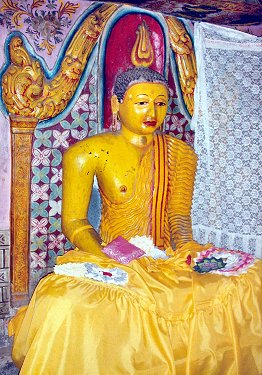
A Buddha statue belonging to the Kandyan period
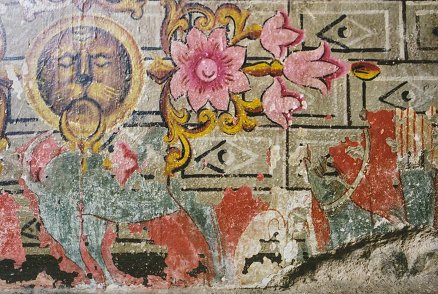
One of the Buddha’s former birth story ‘Kanha Jātaka’ revealing after the peeling of the plaster
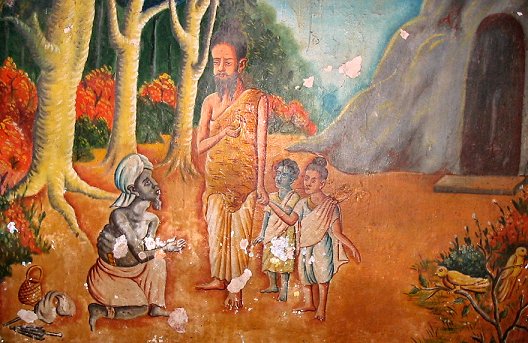
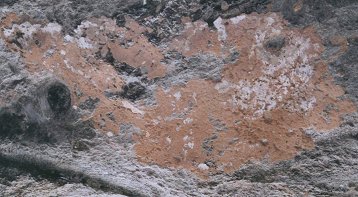
Some fragments of paintings

Picture taken in 1895
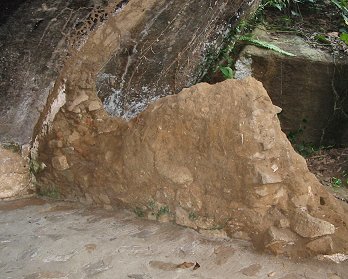
An eighteenth century- year- old remnant wall of mud (wattle and daub), stone, burnt clay, or sometimes brick
It is said that the Dutch set fire to the caves in Aluvihāra and vandalized some
items of archaeological value. “These temples were destroyed by the British
troops in 1803, and only two out of eight have been since restored”. “On a
neighboring crag are the remains of a dāgaba” Explains Major Forbes. In 1848 the
image house along with some statues and some frescoes were destroyed and the
English invading army burned some manuscripts in the library. In the rebellion
held on 28th July 1848 Sinhalese foot soldiers receded confronted with the
British troops. The Sinhalese were in line for an attack the English mixed
Berger troops who were proceeding to Nāladna from Mātale. The English troops
were defeated but Aluvihāra temple was put into a catastrophe by the English
army in retaliation to the Sinhalese foot troops’ attacks.
In 1899 the statues, frescoes and the buildings including the protective wall of
the Bo tree, were restored and reinforced as evidenced today by the late chief
prelate of the Mātale district and the chief abbot of Aluvihāra, Venerable
Tolambugolle Sri Sumangala Nayaka Thero. The late Government Agent of Mātale Mr.
T. B. Aluvihāre and his spouse Pānabokke Tikiri Kumārihamy (parents of Sir
Richard Aluvihāre and Bernard Aluvihāre) patronized to restore the dāgaba and to
construct the stone pandal (arch) and the stone stairway in 1904 in the time of
the chief prelate of the Mātale district and the chief abbot of Aluvihāra
Venerable Tolambugolle Sri Sumangala Nāyaka Thero.
The pictorial wall paintings of hell or the ‘Horror chamber’ as one writer says,
shows “how various forms of punishment handed out by the devils to the sinners
in the after life.”(Hell is referred to Buddhist literature as a state of
suffering that comes in the forms of the retribution for acts of evil holding of
wrong views in acts, speech and thought causes for rebirth. Nevertheless, it is
difficult to trace any evidence in early Buddhist literature that it connoted
any particular location as it associated with the mediaeval European notion of
hell which was believed to be underground). H.W Cawe confirms “Some interesting
frescoes with a striking resemblance in idea as well as in execution to the rude
mediaeval illustrations of the punishments awaiting the impious in a future
state.”
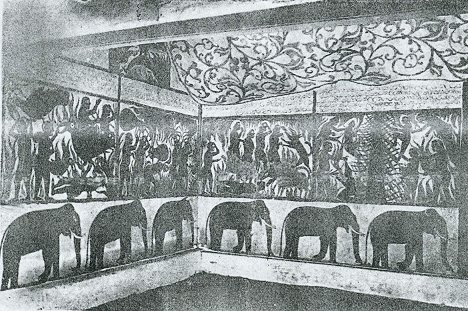
An old pictorial wall painting of hell at Aluvihāra

A new pictorial wall painting of hell at Aluvihāra
In one of the caves a few of thirty-two capital punishments are shown in
sculpture inflicted on the criminals by the last King Sri Vicrama Rājasinghe. He
is known as the cruel king in Sri Lankan royal lineage. He had sentenced bodily
tortures, mutilation of limbs and organs of the Kandyan inhabitants who were
charged with offences. One punishment shows a sexual sinner who has his skull
cut open and is being poured boiling gravel into his head by two tortures while
he is weeping bitterly.
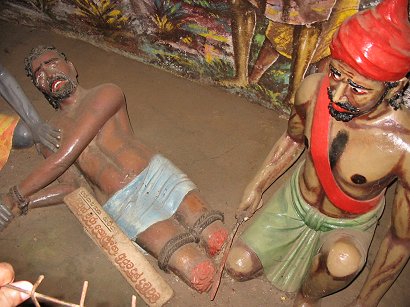
The allotment of land claimed by this temple is situated in the village of
Aluvihāra in the Gampahaseapattoo of the District of Mātale of the Central
Province. In the year 1854 George A.Vetch. Esqre. Asst. Surveyor has furnished
the plan, for Surveyor General, for this allotment at the request of the late
Chief Prelate of the Mātale district and the chief abbot of Aluvihāra Venerable
Tolambugolle Sri Sumangala Nāyaka Thero.
Home | Significance | Access | History | +94 777 783468